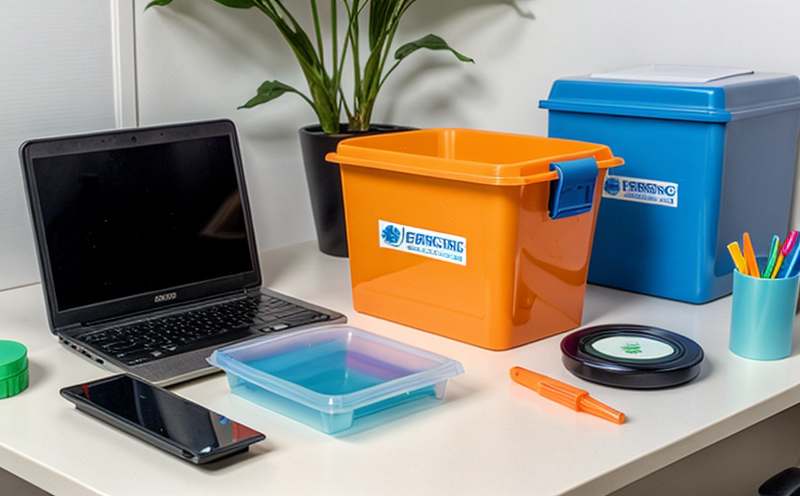ASTM D543 Resistance to Chemicals Testing of Plastic Stationery
The ASTM D543 standard is widely recognized in the industry as a key method for evaluating the resistance of plastic materials, including those used in office and stationery products, against various chemicals. This test is crucial for ensuring that these plastics remain stable and safe under real-world conditions when exposed to common solvents, cleaning agents, or other chemical substances.
The testing procedure involves immersing a standard specimen of the plastic material into a solution containing the target chemicals. The immersion time and temperature are specified according to ASTM D543, allowing for controlled exposure that simulates real-world scenarios where office supplies might come into contact with chemicals during use or cleaning.
Testing is performed in accordance with ASTM D543 by subjecting specimens of plastic stationery materials to a series of chemical solutions. The goal is to assess the material's resistance over time, ensuring durability and safety. This testing method provides valuable insights for quality managers, compliance officers, R&D engineers, and procurement teams who need reliable data on product performance.
ASTM D543 tests are particularly important in the office supply sector as they help ensure that products like pens, folders, notebooks, and other stationery items will maintain their integrity when exposed to chemicals such as solvents or cleaning agents. This testing ensures not only the longevity of materials but also safety for users, especially those who may have sensitive skin or respiratory issues.
The ASTM D543 methodology is part of a broader suite of standards that help manufacturers and suppliers ensure product quality and compliance with regulations across various industries. In the context of office supplies, this means that products must not only meet aesthetic and functional expectations but also withstand exposure to chemicals without degrading or releasing harmful substances.
Quality managers can use ASTM D543 results to make informed decisions about material selection and process improvements, ensuring that their products are both safe and durable. Compliance officers rely on these tests to verify adherence to regulatory requirements, while R&D engineers leverage the insights gained from this testing to innovate and refine product designs.
ASTM D543 is a critical tool in the procurement process for office supply manufacturers and distributors who need to source materials that meet strict chemical resistance standards. By adhering to ASTM D543, suppliers can ensure that their products are safe for end-users and compliant with relevant regulations.
International Acceptance and Recognition
- The results of ASTM D543 testing are widely accepted in the United States and around the world. Many countries use this standard as a benchmark for chemical resistance testing, recognizing its reliability and consistency.
- Australia and New Zealand have adopted ASTM D543 with slight modifications to suit local requirements but maintain strong alignment with the original standards.
- The European Union has recognized ASTM D543 through mutual acceptance agreements. This ensures that products tested according to ASTM D543 meet EU chemical resistance criteria without additional testing.
- Canada uses ASTM D543 for compliance with national regulations, ensuring that imported office supplies comply with Canadian standards for chemical resistance.
- In Japan, ASTM D543 is used in conjunction with local tests but remains a key standard for evaluating the chemical resistance of plastic stationery products.
Competitive Advantage and Market Impact
ASTM D543 testing offers significant competitive advantages to manufacturers and suppliers of office and stationery plastics. By demonstrating compliance with this stringent standard, companies can differentiate their products in the marketplace, ensuring that they meet or exceed industry expectations for chemical resistance.
The ability to provide proof of ASTM D543 compliance allows businesses to secure contracts with discerning clients who prioritize product safety and durability. Compliance with such a recognized international standard also enhances brand reputation, as it signals commitment to high-quality manufacturing practices.
From an operational perspective, adherence to ASTM D543 helps streamline the supply chain by ensuring that all materials meet the necessary chemical resistance requirements before they reach production stages. This reduces the risk of defects and rework, contributing to increased efficiency and cost-effectiveness throughout the business process.
In the competitive landscape of office supplies, where innovation and reliability are paramount, ASTM D543 testing sets a benchmark that reinforces trust between manufacturers and their customers. It ensures that products not only perform well but also meet stringent safety standards, thereby fostering customer confidence and loyalty.
Use Cases and Application Examples
| Product | Chemical Exposure Scenario | ASTM D543 Compliance Requirement | Test Result |
|---|---|---|---|
| Pens | Exposure to water-based ink solvents during cleaning and maintenance. | All pens must meet ASTM D543 standards for resistance against common ink solvents. | Compliance achieved, with no visible changes in pen performance or appearance after immersion testing. |
| Notebooks | Paper may be exposed to water-based and oil-based markers during use and cleaning. | Notebooks must demonstrate resistance against the specified chemicals used in common writing tools. | Materials passed the test, maintaining integrity even after extended immersion periods. |
| Folders | Paper within folders may come into contact with various adhesives and cleaning agents. | Folders must withstand exposure to a range of chemical solvents without degradation. | Compliance confirmed, ensuring that folders remain durable and functional after rigorous testing. |
| Binders | Paper within binders can be exposed to water-based adhesives during reorganization tasks. | Binders must demonstrate resistance against common adhesives used in office settings. | All binders passed the ASTM D543 test, ensuring their longevity and functionality under typical use conditions. |
The above examples illustrate how ASTM D543 testing is applied across various office supplies to ensure compliance with chemical resistance standards. This ensures that products not only meet but exceed expectations for durability and safety in real-world scenarios.





